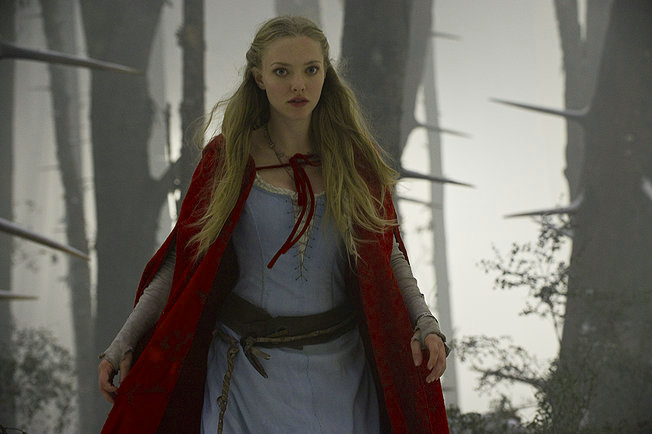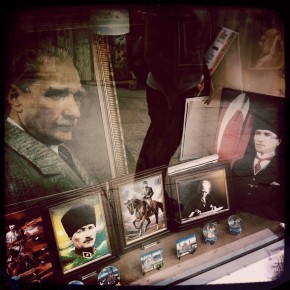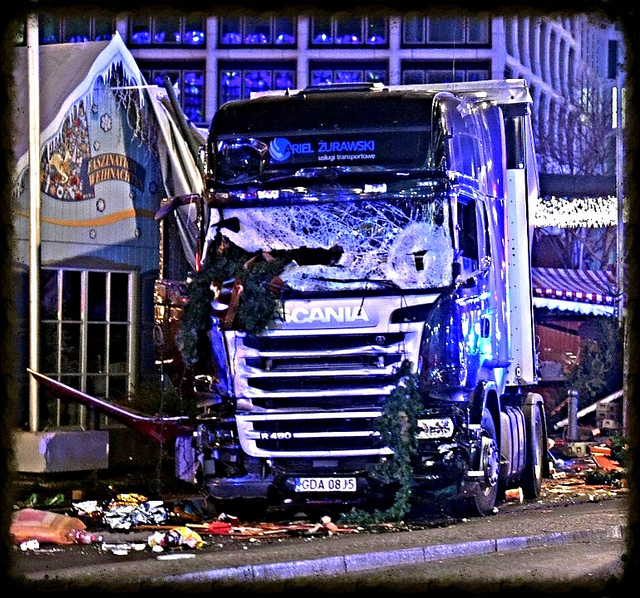Catherine Hardwicke’s Red Riding Hood is a luscious little gothic fairytale. Taking the “Little Red Riding Hood” story and transposing it onto the social landscape of a small, early American village, the movie manages to give this classic a contemporary flair while also maintaining a sense of gothic romance. Without resorting to post-modern irony, Hardwicke delivers a classic beauty and the beast narrative, a coming-of-age story, and a scathing allegory for the American social paranoia that has been rampant in this country from the Salem Witch Trials to today’s politics with such ugly mechanisms as the Patriot Act, the Department of Homeland Security, and Arizona’s SB1070.
When I first left the movie, I knew I enjoyed it even though I recognized that it probably wasn’t a “great” film. But the more I think about it, the more I find to like in Hardwicke’s film because it does manage to be fulfilling on many levels. It’s a lusciously beautiful gothic romance monster movie and a piece of critical social commentary about the paranoia machine that has fed America’s history of intolerance from day one. What more could I ask for?
The fact that the movie operates so beautifully in both these capacities actually makes a lot of sense. The movie plays against two kinds of “uncivil” human tendencies, and in doing so questions the very concept of what is “civil.” While on the surface the movie’s narrative pits humans against a monster, the werewolf, really the movie is about the uncivil practices of civil institutions (e.g. forced marriages, torture, etc.) versus the “uncivil” nature of primal love. The wolf is just a scapegoat for the institutional practices that create the wolf. The real monster in the movie resides not in the wolf but in the intolerance of America’s archaic social systems.
We enter the movie with a pre-adolescent Valerie (Red Riding Hood) and her childhood sweetheart Peter catching a rabbit with a cage. A classic coming-of-age moment, this is when the first blood is spilled. Valerie takes a knife and kills the rabbit for its skin. Certainly the symbolism in this scene is quite obvious, as Valerie is immediately marked with the red blood of the rabbit, the red of her sexuality, and the red that she will be marked with throughout the film. This is a good place to note that though Valerie kills the rabbit, we don’t see the blood, and in fact no blood is witnessed in the film. The only red that is present in the entire movie is Valerie’s Red Cloak, a lusciously rich symbol of her rebellious sexuality and her otherness.
We then jump forward in time to the point where the werewolf narrative enters the story. First we have to learn that Valerie is being forced to marry Henry, a man she doesn’t love, instead of being able to marry Peter, her true love. Meanwhile, her sister Lucy is killed by a werewolf. Even when we see Lucy’s dead body, not a drop of blood is seen. She is splayed at the feet of the villagers with her pink gown spread around her, an image of female sacrifice and of innocence lost, a symbol to inspire further suspicion and paranoia amongst the townspeople. It turns out that the village has been cursed by werewolf attacks for years. Its inhabitants go through all the usual motions – animal sacrifices under the full moon, witch hunts, etc – in an attempt to fend off or catch the wolf, but their efforts prove unsuccessful. The wolf keeps attacking.
The movie cuts back and forth between the tale of Valerie and scenes of the townspeople operating in herd psychology to feed the paranoia that the wolf attacks inspire. At this point we become acquainted with the priest, played by Gary Oldman,who enters the scene as Solomon, the priest who has been called to solve the village’s werewolf problems, but who really ends up just feeding the town’s paranoia and torturing some innocent people along the way. Solomon sweeps onto the scene with his silver fingernails, his purple velvet robe and his giant elephant-shaped torture device.

A psychopath who kills and persecutes in the name of God, Solomon violates privacy and breeds paranoia and suspicion at every turn. His character reminds us that the church is an apparatus of the state and the state an apparatus of the church and that both work to keep people in a state of unease and suspicion which allows the church-state to create absurd laws of intolerance (e.g. the Salem Witch Trials or Arizona’s SB1070). Speaking of Gary Oldman, he plays Solomon with complete over-the-top flourish, and he obviously takes great delight in his role as the psychopathic witch-hunting priest. In other words, he may be a bad guy, but he sure is fun to watch.
In the middle of all of this is Valerie. With all this madness going on, Valerie takes refuge at “Grandma’s House.” Grandma is played by a beautifully witchy Julie Christie, and Grandma’s house is rich with rustic paganism. Christie’s nuanced acting, the set design of Grandma’s house with its primitive talismans, herbs, trinkets and general “otherness,” and the angles of the cinematography make Grandma more than a little suspicious. Julie Christie’s Grandma is no pretty pink little old lady in a bonnet. She seethes with an underlying sexuality (as Christie always does), and her character is rich with a passionate energy and a sense that she is the holder of a whole world of secrets. When Grandma hands Valerie the crimson cloak that she will wear throughout the rest of the film, we understand that she is passing along so much with that garment – the burden of her gender, the mark of magic, and her blessing for Valerie to follow her passions and rebel against the claustrophobia of social institutions like arranged marriage.

In the meantime, the wolf has killed the father of Henry, the man Valerie is ordained to marry, and the town is on a witch hunt for the killer. Henry and Peter are simultaneously at odds with each other and working together to help Valerie. A village idiot mumbles incoherent prophecies. Houses are pillaged for signs of the wolf, and the movie is a hotbed of paranoid suspicion with Red Riding Hood in the middle. The cinematography casts suspicion on nearly every character, as they all glance sideways at the camera provoking us to question their innocence. The plot throws curve ball after curve ball making nearly everyone seem guilty of something. In doing so, the movie inspires the audience to become suspicious of nearly every character who crosses the screen. As Solomon enjoins the townspeople to look at each other for signs of the wolf and tells them that the monster is amongst them, the movie asks us to do the same. “Who is the wolf?” we can’t help but ask, and we become complicit in the whole environment of paranoia and suspicion.
Visually we feel the cage of this small town’s social paranoia through various cage-like images. People peer suspiciously through small barred windows or out of criss-crossed shadows. They lurk outside of doors and pop up out of dark corners. The movie is full of traps and a network of social claustrophobia, beginning with the basket rabbit trap in the beginning of the film. Most striking is the creepy dog/pig mask that Solomon forces Valerie to wear as a mark of her position of social outcast, a kind of “scarlet letter” communicating her public shame. Speaking of the Scarlet Letter, the movie very much operates like one of Nathaniel Hawthorne’s gothic tales of early America, particularly the creepy paranoid claustrophobia of his story “Young Goodman Brown” and the archaic persecution of women in the Scarlet Letter. As in Hawthorne, the whole movie is infused with a kind of dark spirit that cuts between two worlds – the primal spirit of human passion (e.g. the forest/the wolf) versus the paranoid claustrophobia of the mass social spirit of humans in constructed society (the church/the state). Actually, thinking about how the movie manages to both invoke Hawthorne and the xenophobia and paranoia that plague today’s American landscape, it’s amazing how little has changed in this country since Hawthorne published The Scarlet Letter in 1850.
It’s interesting how little blood is actually shed in the movie. Thinking about whether or not my daughter could handle watching it (since she has a pathological aversion to blood in cinema), I realized that none of the “wolf violence” is shown on screen. The wolf enters in a blur. There is some abstract chaos, growling and screaming, but we don’t really see any wolf carnage. Sure some people die. We see a couple of bodies, but they are laid out on the screen more like aesthetic objects that are symbols of the larger problem – the social group. When Henry’s father dies, it’s a vehicle to see the men in action as a group out to take revenge. When Valerie’s sister dies, her body is presented like a talisman, with more focus on her pink dress (innocence lost) than her actual dead body. The focus is not on Lucy, but on the social group’s paranoid reaction to her death. We don’t see blood or violence because the real violence of the film doesn’t come from the wolf but from the archaic customs and the group mentality of the village that enforce those customs. In one of the wolf rampage scenes, the wolf ends up face-to-face with Valerie, and he actually speaks to her, beckoning her to “leave this place” and join him in freedom.
Needless to say, the wolf speaking to Valerie is a bit of a problem. She is already marked by her red cloak, and now she is further marked by the fact that she can “speak” to the wolf and understand the primal beast. This brings us to the female sexuality at the core of this beauty and the beast story. In director Catherine Hardwicke’s hand, the fairytale becomes a kind of feminist treatise where we see what havoc is created when social customs interfere with primal female desire and sexuality. Valerie’s red cloak isn’t just a symbol of her own sexuality but of the legacy that has been passed onto her by generations of women, as seen in her mother and grandmother, whose freedom has been compromised by archaic systems like arranged marriages and who are deemed witches if they fail to conform to those customs. Valerie’s red cloak is both a symbol of her coming of age (blood, maternity, sexuality) but also the cloak of the mark/burden of being female in the social structure. Solomon refers to the red cloak as that of a “harlot.” The dog mask scene also shows Valerie, now that she has reached sexual maturity, as a kind of dog monster, a breeding bitch.
That these three women have had to live lies and compromise their hearts reveals the fallacy of the institutionalized American family. Through Valerie’s odyssey, we discover that the grandmother was secretly married to a wolf, that Valerie’s father is a wolf, and indeed that Valerie herself is part wolf. In fact, maybe the point is that all of us are born “part wolf,” but are encouraged to kill the wolf in us for the sake of society. We also discover that the mother was forced into an arranged marriage and has an illegitimate daughter from her lover (both of whom her husband the wolf kills). Valerie is being forced by her parents to marry someone she doesn’t love. In other words, the whole family is deeply dysfunctional, full of secrets, betrayals, murder, deceit, and corruption. Why? Because the social system wants to control the family and human relationships, putting a ban on primal passion in the name of social order.
How does this whole mess get resolved? By Valerie killing the father (her literal father) with the hand of the Father (the priest Solomon)! The father, the spearhead of institutionalized social order, has to be killed to let primal love and freedom reign. So Valerie, with her crimson cloak and the severed hand of the priest in her Red Riding Hood basket, takes control of the situation and reclaims primal passion by killing the father.
Sure, Peter becomes a wolf too, but he learns to manage his primal beastly side rather than giving into social control. This is when the movie gets back to its classic fairytale romance story. It is such an incredibly beautiful moment when Peter comes back in his wolf body, and Valerie looks into his eyes. It literally brought me to tears. Speaking of beautiful moments, the scenes with Peter and Valerie in the snowy mountains with her crimson flowing cloak trailing behind her are astoundingly breathtakingly beautiful. You have to have a pretty jaded heart not to be won over by those visions of romantic beauty.
Politics and social allegories aside, Red Riding Hood is also just a lusciously gorgeous gothic fairytale that is enormously fun to watch just for the beauty of it. The cinematography, costumes, set designs and soundtrack all work together to create a gorgeously textured gothic film. While the camerawork with the misty magical forests, the claustrophobic villagescapes and the fantastically sublime snowy mountains and burgeoning skies create an overall atmosphere of gothic magic, the soundtrack infuses the film with an aesthetic texture that meshes the heartbeat of primal human passion with the buzz of social paranoia that runs through the film.
Brian Reitzell’s electronic score creates a beautifully edgy atmosphere, touching on a sublime place of lost mysticism while also invoking the edge of dread and doom that lurk within the herd of the village, while Fever Ray’s rich, hallucinatory, pleading songs bring us straight into the realm of the gothic fairytale, stripping away any potential post-modern veneer and leading us straight into the heart of primal passion and longing. The surreal Blood Moon dance scene that is scored to a Fever Ray song beautifully pits humanity’s primal core against the mass social structure of the group. To me, the masterful use of music in the film really brings the whole thing together and allows Hardwicke’s Red Riding Hood to be a classic gothic fairytale that manages to maintain a sincere romantic heart (in the true sense of romanticism) but also bring it to the here and now with sincerity, passion, and a lot of beauty.
In other words, don’t let Red Riding Hood’s surface tale fool you. Sure, we’ve seen beauty and the beast narratives and film renditions of fairytales before, but the more you look into Hardwicke’s Red Riding Hood, the more there is to see. What makes it so good is that we are able to see the beautiful and the ugly simultaneously, wrapped together in a powerful vision of both human potential and the ways we find to limit ourselves.




